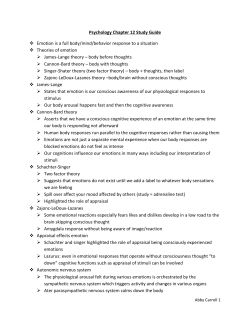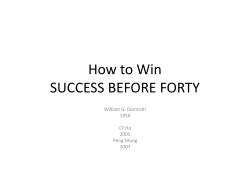
Call for Papers Organization Studies Beyond the Gap: Discovering the Impact and Importance
Organization Studies Call for Papers for a special themed section on: Beyond the Gap: Discovering the Impact and Importance of Studying Emotions & Institutions Guest Editors: Charlene Zietsma, Schulich School of Business, York University, USA Madeline Toubiana, Schulich School of Business, York University, USA Deadline for submission: March 31, 2015 The relationship between emotions and institutions is an emerging area of inquiry beginning to attract significant interest. Extant work in institutional theory has a cognitive and rational bias that masks both the emotional impact that institutions have on individuals’ lives (Creed, Dejordy & Lok, 2010; Creed, Hudson, Olkhuysen & Smith-Crowe, 2014), and the motivational force that emotions have for stimulating institutional work (Voronov & Vince, 2012; Toubiana, Zietsma & Bradshaw, 2013). As Friedland (2013: 44) described: “institutional life … demands myriad moments of located passion”. Related areas have also explored the effects of emotions on social outcomes and processes, identifying how anger can be used to mobilize social movement members to action (Goodwin & Jasper, 2006; Jasper 2011), how emotions can be “managed” in the service of organizational outcomes (Hochschild, 1983; Rafaeli & Sutton, 1987), and how emotions can be amplified in social settings (Collins, 2004; Hallett, 2003). Early studies examining emotions in institutional theory have shown that emotions have important impacts such as: stimulating institutional work (Toubiana, Zietsma, & Bradshaw, 2013; Voronov & Vince, 2012), institutional conformity, disruption and recreation (Creed, Hudson, Okhuysen, & Smith-Crowe, 2014), energizing and constituting institutional logics (Friedland, Mohr, Roose, & Gardinali, 2014); influencing actor involvement in emerging fields (Grodal & Granqvist, 2014), and legitimacy and network spillovers (Haack, Pfarrer, & Scherer, 2014). Yet, while there is a growing acknowledgement that emotions have been understudied and undertheorized in institutional theory (Creed, Dejordy, & Lok, 2010; Creed et al., 2014; Voronov, forthcoming; Voronov & Vince, 2012), we have little understanding of why such study is important. What role do emotions play in key institutional processes like change, persistence and agency? How are institutional phenomena like reflexivity, identity and logics shaped or altered by emotion? Are emotions constituted by or constitutors of institu–1– tional dynamics? How – and why – do emotions matter? In this special themed section of Organization Studies, we are seeking to move “beyond the gap” to identify how and why emotions matter to core institutional processes and phenomena. Our goal is to consider the diverse ways in which emotions may play a role in the enactment, management, persistence and change of institutions to determine whether there is, or should be, a place for emotions in the study of institutions. Key questions and themes We encourage contributions that adopt a wide variety of perspectives on institutional dynamics, such as: institutional work, institutional logics, institutional complexity, legitimacy and microfoundations. We are open to multiple levels of analysis individual, organizational and field as well as to diverse methodological approaches. The following questions highlight potential areas of interest, but we welcome submissions that go beyond these issues. Do different institutional logics authorize particular emotional experiences and performances? How might these distinctions shape the experience and interactions between logics? In what ways do emotions and cognitions interrelate in institutional logics? How are emotions implicated in institutional work, involving the enactment, defense, disruption and creation of institutions (Lawrence & Suddaby, 2006; Maguire & Hardy, 2009)? How is emotional energy (Collins, 2004) activated and generated for institutional work? What differences are there between emotions that are deployed strategically and those that are triggered through experience, violation, or interaction? How are emotions implicated in clashes between contradictory institutional logics? What impacts do emotions have on the combination of elements from different logics (Pache & Santos, 2012), or on the management of constellations of logics (Goodrick & Reay, 2011)? If institutional logics authorize different emotional experiences and expressions, how are conflicting “emotion rules” managed in hybrid organizations of various types? Beyond being rhetorical devices, how does the experience and expression of emotion shape the response to and dynamics of field interactions? Are some emotions more salient or influential in institutional dynamics than others? Do negative versus positive emotions have different influences on institutional processes or phenomenon? Submissions Organization Studies is hosted on SAGE track a web-based online submission and peer review system powered by ScholarOne™ Manuscripts. Visit http://mc.manuscriptcentral.com/orgstudies to login and submit your article online. Once you have created your account and you are ready to submit your paper you need to choose this particular special themed section from the drop down menu that is provided for the type of submission. IMPORTANT: Please check whether you already have an account in the system before trying to create a new one. If you have reviewed or authored for the journal in the past year it is likely that you will have had an account created. For further guidance on submitting your manuscript online please visit ScholarOne Online Help. All papers will be double-blindly reviewed following the journal’s normal review process and criteria. Any papers which may be accepted but will not be included in the special themed section will be published in an ordinary issue at a later point in time. –2– For further information please contact one of the guest editors for this special themed section: Charlene Zietsma, czietsma@schulich.yorku.ca; or Madeline Toubiana, mtoubiana09@schulich.yorku.ca. References Collins, R. (2004): Interaction Ritual Chains. Princeton, NJ: Princeton University Press. Creed, W.E.D., Dejordy, R., & Lok, J. (2010): “Being the change: Resolving institutional contradiction through identity work.” Academy of Management Journal, 53 (6), 1336–1364. Creed, W.E.D., Hudson, B.A., Okhuysen, G.A., & Smith-Crowe, K. (2014): “Swimming in a sea of shame: incorporating emotion into explanations of institutional reproduction and change.” Academy of Management Review, 39 (3), 275–301. Friedland, R. (2013): “God, love and other good reasons for practice: Thinking through institutional logics.” In: M. Lounsbury & E. Boxenbaum (eds.): Institutional Logics in Action. Research in the Sociology of Organizations, Vol. 39A. Bingley: Emerald Group Publishing, pp. 25–50. Friedland, R., Mohr, J.W, Roose, H., & Gardinali, P. (2014): “The institutional logics of love: measuring intimate life.” Theory and Society, 43, 333–370. Goodrick, E., & Reay, T. (2011): “Constellations of institutional logics: Changes in the professional work of pharmacists.” Work & Occupations, 38 (3), 372–416. Goodwin, J., & Jasper, J.M. (2006): “Emotions and social movements.” In J.E. Stets & J.H. Turner (eds.): Handbook of the Sociology of Emotions. New York: Springer, pp. 611–636. Grodal, S., & Granqvist, N. (2014): “Great expectations: Discourse and affect during field emergence.” In N.M. Ashkanasy, W.J. Zerbe & C.E.J. Härtel (eds.): Emotions and the Organizational Fabric. Research on Emotion in Organizations, Vol. 10. Bingley: Emerald Group Publishing, pp. 139–166. Haack, P., Pfarrer, M.D., & Scherer, A G. (2014): “Legitimacy-as-feeling: How affect leads to vertical legitimacy spillovers in transnational governance.” Journal of Management Studies, 51 (4), 634–666. Hallett, T. (2003): “Emotional feedback and amplification in social interaction.” The Sociological Quarterly, 44 (4), 705–726. Hochschild, A. (1983): The Managed Heart: Communication of Human Feeling. Berkeley: University of California Press. Jasper, J.M. (2011): “Emotions and social movements: twenty years of theory and research.” Annual Review of Sociology, 37, 285–303. Lawrence, T.B., & Suddaby, R. (2006): “Institutions and institutional work.” In: S.R. Clegg, C. Hardy, T.B. Lawrence & W.R. Nord (eds.): Handbook of Organization Studies, 2nd ed. London: SAGE Publications, pp. 215–254. Maguire, S., & Hardy, C. (2009): “Discourse and deinstitutionalization: The decline of DDT.” Academy of Management Journal, 52 (1), 148–178. Pache, A.-C., & Santos, F. (2012): “Inside the hybrid organization: Selective coupling as a reponse to conflicting institutional logics.” Academy of Management Journal, 56 (4), 972–1001. Rafaeli, A., & Sutton, R.I. (1987): “Expression of emotion as part of the work role.” Academy of Management Review, 12 (1), 23–37. Toubiana, M., Zietsma, C., & Bradshaw, P. (2012): “Why won’t you advocate for us? Exploring the disruptive institutional work of marginalized stakeholders.” Academy of Management Proceedings, 1–6. Toubiana, M., Zietsma, C., & Bradshaw, P. (2013): The message is on the wall: Emotions, institutional expectations, and the dynamics of emotive institutional work. Paper presented in subtheme 07 at the 29th EGOS Colloquium in Montréal, Canada, July 4–6, 2013. Voronov, M. (2014): “Towards a toolkit for emotionalizing institutional theory.” In N.M. Ashkanasy, W.J. Zerbe & C.E.J. Härtel (eds.): Emotions and the Organizational Fabric. Research on Emotion in Organizations, Vol. 10. Bingley: Emerald Group Publishing, pp. 167–196. Voronov, M., & Vince, R. (2012): “Integrating emotions into the analysis of institutional work.” Academy of Management Review, 37 (1), 58–81. –3–
© Copyright 2025















